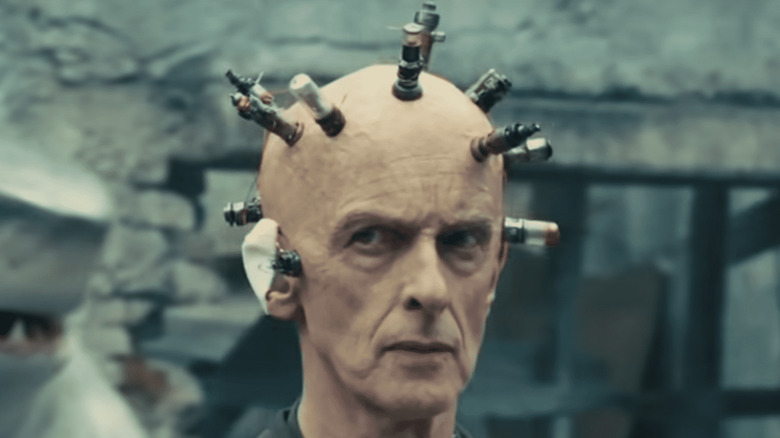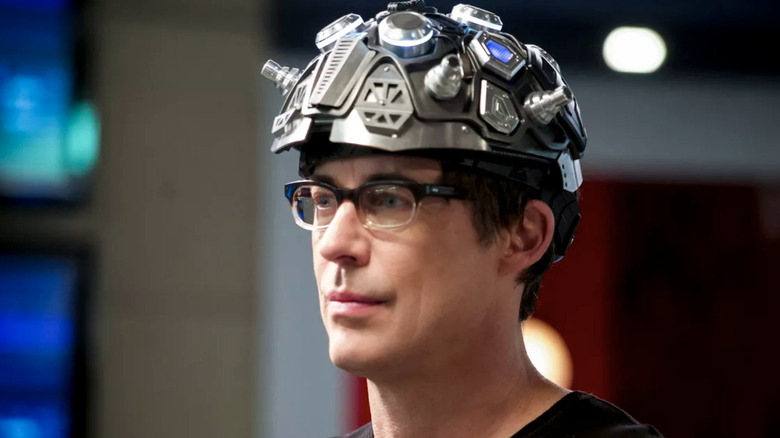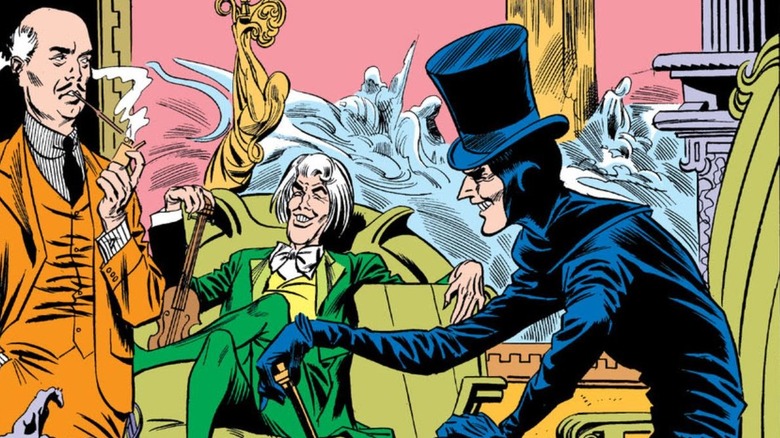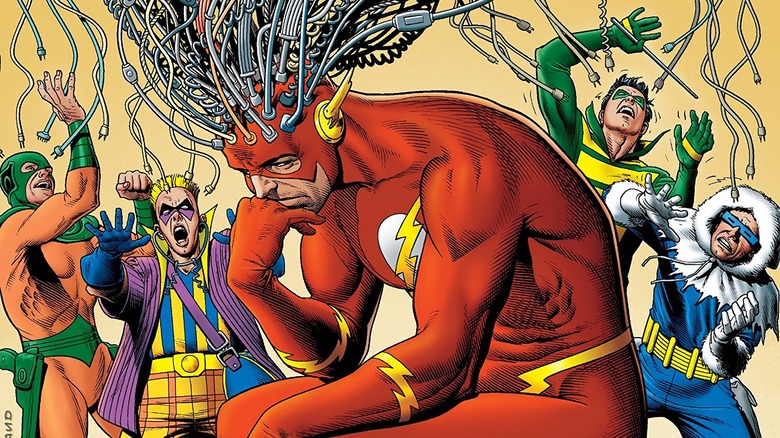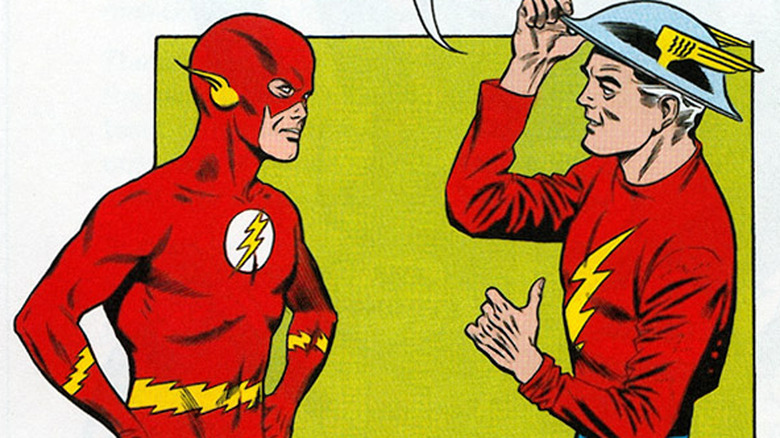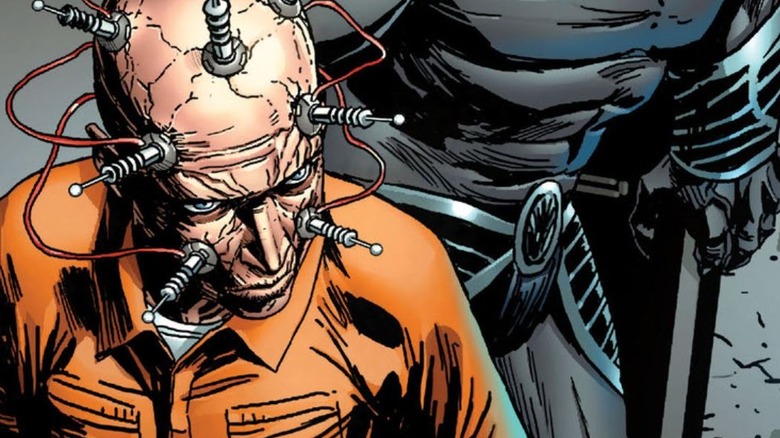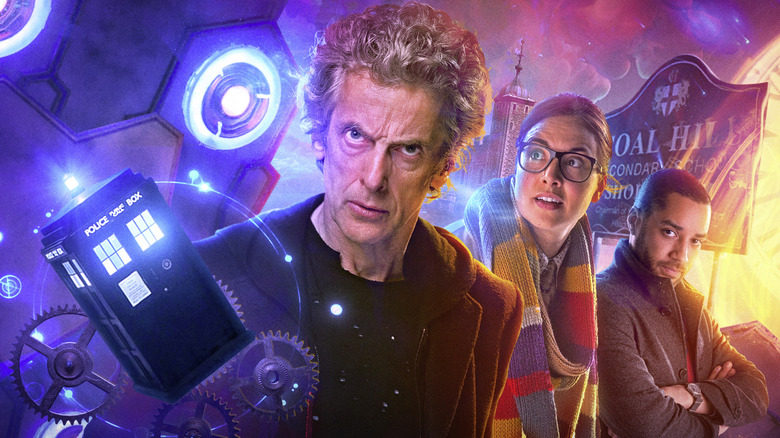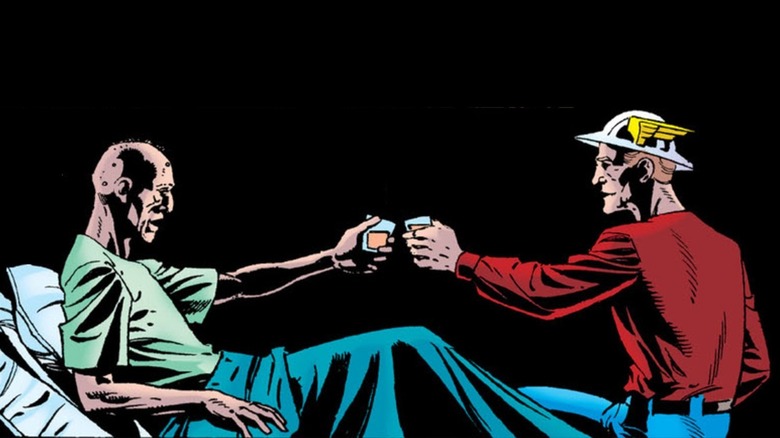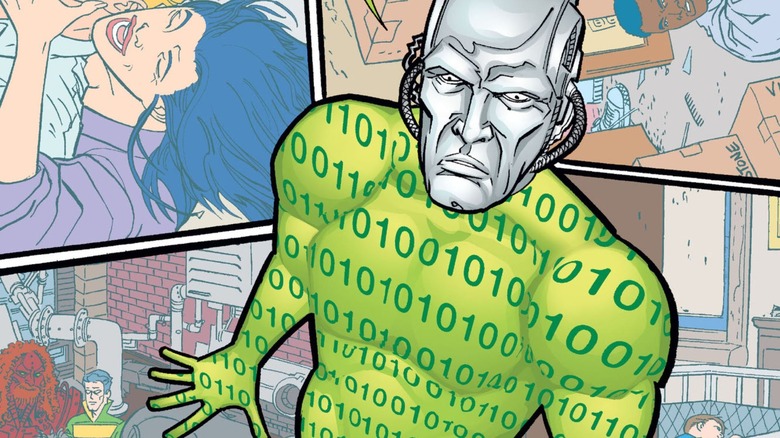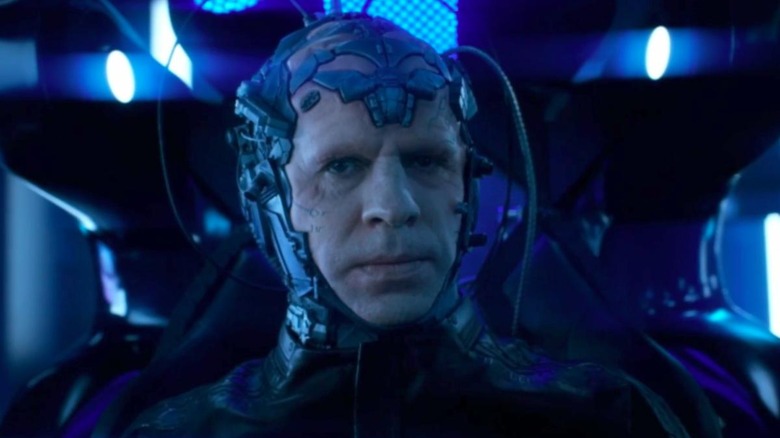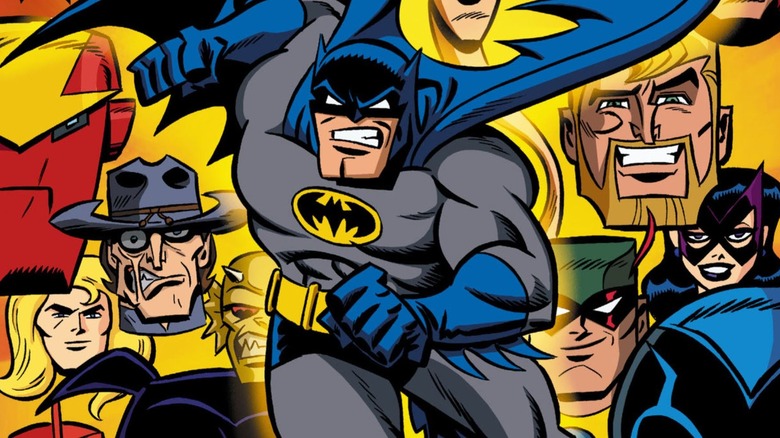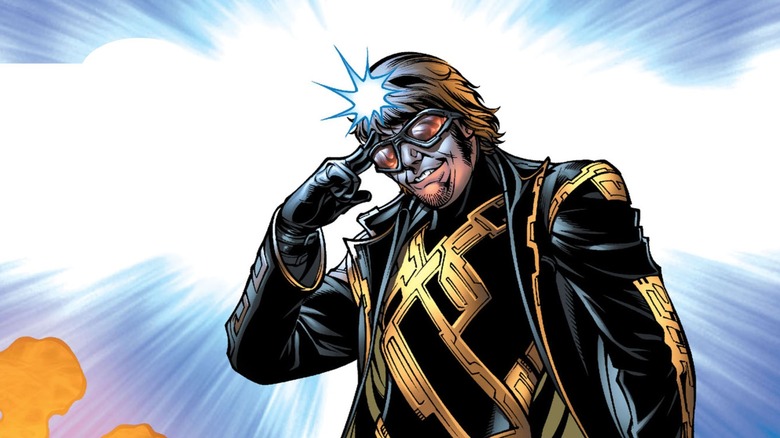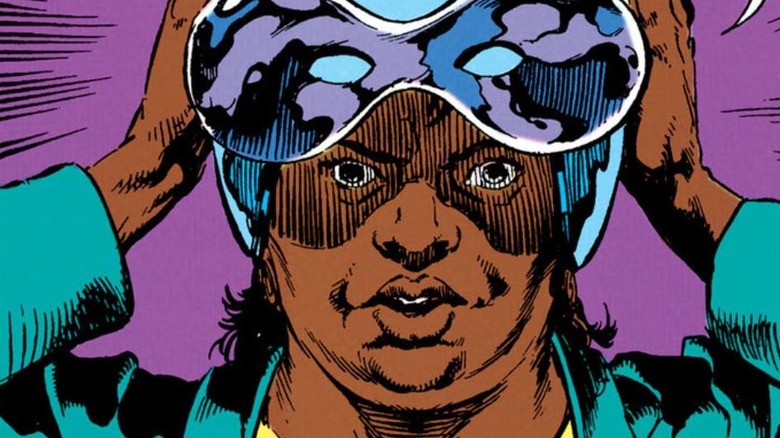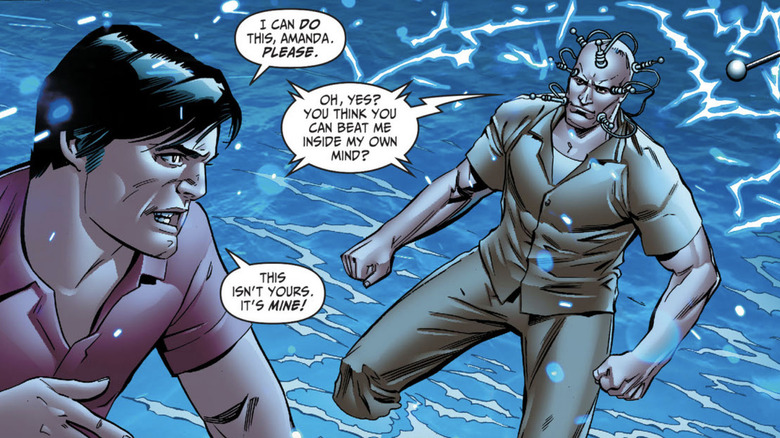The Untold Truth Of DC's Thinker
Played by Peter Capaldi in James Gunn's "The Suicide Squad," the Thinker is one of DC Comics' oldest super villains, and his frequent appearances across DC's films and television series in recent years has brought the character a level of fame he has never held before. It's also a fame that might just stick around, as the Thinker is one of DC Comics' more unique genius-level characters.
As the name implies, the threat and danger of the Thinker lies not in his physical abilities but instead in his tricks, tactics, and traps. He is not a mad scientist like some of DC Comic's other evil geniuses like Lex Luthor or Shazam's Dr. Thaddeus Sivana. Words are his weapons, plans are his artillery, and intricate strategies are his death traps. There are some memorable reasons why the Thinker has managed to stick around for the last 80 years — here are just a few.
His powers originated with his "Thinking Cap"
Most versions of the Thinker gain or enhance their abilities through a piece of scientific head-ware known as his "Thinking Cap." Though the Thinker already possesses a grand intellect without the helmet, the device increases his brainpower a hundred-fold, often allowing him to outthink even the Fastest Men Alive.
Introduced in "All-Flash" #32 in 1948, the Thinking Cap doesn't always grant the Thinker the same abilities. Some versions simply improve the villain's intelligence. Others grant him limited literal superpowers, like telepathy and telekinesis.
This aspect, like the shape and form of the helmet, are inconsistent and often change. Traditionally, it looks relatively similar to a metal version of a standard bicycle helmet that has been adorned with rods, spikes, sensors, scanners, domes, and other gizmos to give it that science fiction flair. Other versions fit more closely to the classic super-villain costume aesthetic and are oblong purple domes that double as a mask in an attempt to hide DeVoe's identity.
Most modern interpretations ditch the idea of a traditional helmet in exchange for more high-tech, or even grotesque, solutions. One version had no helmet at all and instead had the helmet's technology implanted throughout his body, while the version James Gunn based the look of his Thinker on simply has metal rods protruding directly out of his skull.
He was introduced in the 1940s
Introduced in the fall of 1943, Clifford DeVoe, the original Thinker, launched his super-criminal career in "All-Flash" #12 through a series of intricate robberies that kept original Flash Jay Garrick busy or distracted while his men stole jewels, payrolls, and priceless artifacts right out from under his nose.
DeVoe was a District Attorney who realized that crime did pay, and spent ten years as a sort of master planning "consultant" for one of Keystone City's most vicious mob bosses. DeVoe eventually became bored of his role and took over the gang for himself, thus launching his career in earnest.
Though he was eventually defeated by the speedster, the Thinker returned to threaten Keystone City with his intellect multiple times throughout the Golden Age of Comics, cementing himself as one of the original Flash's most dangerous enemies.
Though he has since become famous for his Thinking Cap, DeVoe didn't actually receive the device until his last Golden Age appearance in 1948's "All-Flash" #32. Before then, he utilized his un-enhanced intellect and nearly beat the Flash multiple times anyway.
He's a long-time foe of the Flash and the JSA
The Thinker's status as one of the most important members of the original Flash's rogues gallery of villains would have been more than enough to cement himself a place of significance in the histories of DC Comics' Fastest Man Alive, but DeVoe has returned time and again to challenge the wits of nearly every version of the Scarlet Speedster.
After battling against Jay Garrick, he went on to trouble Jay's successor, Police Scientist Barry Allen, a founding member of the Justice League, as well as the third Flash, Wally West.
If that wasn't enough, the Thinker also helped found the original version of the Injustice Society of America, the evil counterpart to the Golden Age superhero team, the Justice Society of America. In All-Star Comics #37, the Thinker teamed up with Vandal Savage, Per Degaton, the Gambler, and the Wizard to conquer the world. They were narrowly defeated, but that hasn't stopped the Thinker and the rest of the Injustice Society from trying again repeatedly over the years to come.
He's responsible for the famous story "Flash of Two Worlds"
The Thinker's greatest victory over the Flash is not only one of the most famous Flash stories of all time, it's also one of single most important and influential comic books in the history of the DC Universe. Written by Gardner Fox and drawn by Carmine Infantino, "Flash of Two Worlds" was published in 1961's "The Flash" #123.
The story featured the first appearance of the original Flash, Jay Garrick, since his Golden Age "Flash Comics" series had ended in 1949 with issue #104. This appearance presented a number of challenges. Barry Allen's first appearance in 1956's "Showcase" #4 clearly established Jay Garrick as a fictional comic book character. Barry had even taken on the name because he read the real-world "Flash Comics" series as a kid.
To explain this, DC officially introduced the idea of a multiverse for the first time, setting in motion a series of events that eventually culminated in the original "Crisis on Infinite Earth" — creating the idea of the "comic book event" and inspiring countless adaptations to the present day.
All of this from the Thinker's plan to trap the Flash, and all of Keystone City, and hide it from the rest of the universe with the help of the Fiddler and the Shade. That's quite a feat.
He can be terrifying
In a world where children can topple mountains and gods can travel throughout multiverses during an afternoon walk, "smart" might not seem like much, but his schemes regularly leave a being that can move and think at the speed of light feeling stumped and confused. As a result, his great victory in "The Flash" #123's "Flash of Two Worlds" is utterly horrific.
The story features the first two Flashes meeting for the first time, but after the multiverse was destroyed in "Crisis on Infinite Earths" in the 1980s, the story had to be adjusted, and these changes turned the light-hearted tale into a dark affair.
In the original, Barry accidentally travels to Earth-2, meets Jay Garrick, helps him stop the heists of three supervillains, and goes home. In the later version, Barry still accidentally discovers Jay Garrick, but this time its because the Thinker used the Shade and the Fiddler to place all of Keystone City out of phase with the rest of reality for decades.
Though Barry Allen eventually restored the city to normal space, the city was essentially held in stasis for half a century. Time didn't pass for them, but it did for everybody else. Though Keystone's citizens hadn't aged a day, everyone they loved outside the city limits had long since passed away. Their infrastructure and technology were comparatively ancient, and they suddenly found themselves thrust into a brand new world they had never wanted or expected.
He's essentially an evil version of Peter Capaldi's Doctor Who
In 2013, the BBC announced that Peter Capaldi would be the twelfth actor to play "Doctor Who." In 2020, James Gunn announced that Peter Capaldi would be the Thinker in "The New Suicide Squad." This might just be the most fitting casting in Gunn's new DC movie.
For those unfamiliar with the long-running British science fiction series, "Doctor Who" features an alien known only as "The Doctor" as he travels through time and space fighting monsters alongside his friends with nothing but his wits — and Peter Capaldi's version of the character, the "Twelfth Doctor," was a particularly cerebral incarnation of the character.
His intelligence was so intense at times that he was essentially a superhero. Whether he was creating complex programs with mere seconds of access to a computer or memorizing complicated codes with only a brief glance, this version of the Doctor focused heavily on the character's massive intellect, even going so far as to dedicate an entire episode in 2015 called "Heaven Sent" to exploring exactly how he always manages to outwit his opponents and win.
The Thinker is, at his best, essentially an evil version of Capaldi's most famous character. The Doctor has defeated literal gods with nothing but his wits, and whether it's with the help of his Thinking Cap or without it, this is exactly the kind of feat of which the Thinker is truly capable.
He isn't always a villain
None of this means the Thinker is always evil, however. In fact, by the time of Clifford DeVoe's death in "The Flash" #134, he had long since reformed. Cowritten by Mark Millar and Grant Morrison, the issue is a self-contained story featuring Jay Garrick as he tries to find DeVoe's old helmet so the Thinker can figure out a way to save his own life.
Both old men by this point, DeVoe retired from his life of crime and paid his debts to society after he discovered that he had an inoperable brain tumor that was going to end his life. He made amends with Garrick and the two even became close friends, but when Jay Garrick finally found the Thinking Cap, brought it to DeVoe, and used it to temporarily restart the man's heart, the old villain simply told him "no."
He explained to Jay that heroes can't always save everybody, and that it was simply his time to go. The old enemies said their goodbyes, and DeVoe removed his helmet and passed away.
He became an Artificial Intelligence
Though that might have been the end of Clifford DeVoe, it was far from the end of his Thinking Cap. The helmet passed through many hands in the years after DeVoe's death, but when Mister Terrific of the JSA recovered the helmet, he discovered that it had created and stored an imprint of DeVoe's consciousness at the moment of his death.
Using this data, Mister Terrific managed to create an artificial intelligence based on the old villain in 2000's "JSA" #10, but the man's altruism didn't survive the process intact. The AI gained a mind of its own, used holograms to give itself a "body," rebelled against the Justice Society, and joined the latest version of the Injustice Society before he was defeated in "JSA" #17.
The artificial intelligence then escaped into the ether, concentrating its efforts on his home town of Keystone City. With his vast intellect, he soon controlled most of the city's underworld and created a device that would allow him to mind control the entire planet. With the help of Cyborg, the third Flash, Wally West, eventually managed to defeat the villain like his heroes had before him.
He has appeared in live action before
Though James Gunn's "The Suicide Squad" is the Thinker's first live-action appearance in a film, it is not his first appearance in live-action overall.
Clifford DeVoe was the overarching villain of the fourth season of the CW's hit series "The Flash." Played most significantly by Neil Sandilands, this version of Clifford had grown tired of how thoroughly mankind was ruining itself.
He felt that all of humanity's issues were self-inflicted and easily fixed, but that they would never actually manage to do it because of their foolishness. Because of this, he wanted to make everybody on the planet to achieve "Enlightenment" by forcibly regressing their intelligence to pre-technological levels so that he could rule the planet and raise them all "properly."
Throughout the season, DeVoe always seemed a dozen steps ahead of the Flash and his team of heroes at STAR Labs. He figured out the Flash's secret identity as Barry Allen, had Barry convicted of murder and imprisoned, and murdered metahuman after metahuman, taking each one's powers for his own until he was one of the most powerful metahumans on the planet.
Despite his superior intelligence and powers, the Flash still managed to destroy the satellite DeVoe needed to achieve his "Enlightenment," but the fact remains that few of the speedster's villains have ever challenged him so thoroughly.
He's only made two minor animated appearances to date
The Thinker has appeared as a minor character in two different animated series. In the second season of Bruce Tim's famous "Justice League Unlimited" television series, Lex Luthor joined Gorilla Grodd's Legion of Doom, a secret society of supervillains working together to subvert the efforts of the Justice League without tipping them off to their existence.
The Legion worked together to pull off heists without being caught, freeing each other when things went wrong. The Thinker was first seen in the background during Lex's tour of their base in "I Am Legion." He was next seen in "Flash and Substance," at a Central City bar catering exclusively to the Flash's many supervillains. His final appearance depicted the villain attending a Legion meeting during "The Great Brain Robbery."
The Thinker's only other animated appearance was in a 2008 episode of "Batman: The Brave and the Bold" titled "Sword of the Atom." In it, Ryan Choi had become the second Atom after his predecessor, Ray Palmer, retired. Choi worked with Batman to defeat Chronos, one of Palmer's most deadly enemies, and while Batman reflected back on all the times he had worked with Ray Palmer, the duo were briefly seen thwarting one of the Thinker's many scenes.
Live action has clearly proved a far kinder medium for this supervillain.
There is more than one "Thinker"
Months before "The Suicide Squad" would be released, James Gunn confirmed that Peter Capaldi's version of the Thinker was not DeVoe. There is a strong precedent for this in the comics.
Introduced in "Firestorm" #1 in 1978, the second Thinker, Clifford Carmichael began his comic book history as Firestorm's high school bully, with Cliff admitted into a mental ward after one of his pranks accidentally paralyzed his cousin in 1986's "Firestorm: The Nuclear Man" #53.
For unknown reasons, scientists at the institution chose to use Carmichael as a guinea pig in their illegal experiments with DeVoe's old Thinking Cap, which helped Carmichael function again and increased his intelligence enough to create new, microchip-sized versions of the Thinking Cap, implant them into his own brain, and debut as the new Thinker in 1987's "Suicide Squad" #48.
The only other significant version of the Thinker appeared in one story that lasted from 2013's "Suicide Squad" #24 to 2014's "Suicide Squad" #29. This Thinker's real name was unknown, but he suffered from a form of cellular degeneration. The more he thought, the more his body deteriorated, and though he was only 25, he looked to be in his seventies. Though this Thinker only appeared the one time, he is significant for one important reason: This is the look that James Gunn chose for his film.
No, Seriously, there are a LOT of them
Despite the measure of obscurity the villain has retained for most of his existence, a truly surprising number of people have taken on that name for one reason or another. Many of these people are simply various characters, like "The Suicide Squad's" Amanda Waller, who wore the helmet for a brief time in 1987's "Suicide Squad" #48.
Surprisingly, however, though only Clifford has survived until the present day, DeVoe was not the only Golden Age DC Comics villain to be called "the Thinker." One such criminal was a man named Goofty Garlow who stole a "thinking computer" that could supposedly solve any problem. He used it to commit crimes until Plastic Man defeated him in 1946's "Police Comics" #54.
There was also a series of gangsters with the name that troubled Superman and then Batman. The first of the bunch was defeated in "Action Comics" #70 in 1944, when the Man of Steel pretended to go on vacation to make the villain drop his guard. The second and third "Thinkers" were crime lords in Gotham City that Batman defeated in 1947's Detective Comics #125 and 1949's "Batman" #52 respectively. The final alternative "Thinker" was a crime boss in Metropolis who tried to get inside info on Superman by kidnapping Jimmy Olsen in 1954's "Superman" #93. He did not succeed.
He has a history with the Suicide Squad
James Gunn's "The Suicide Squad" is far from the character's first interaction with the infamous team. Though Clifford DeVoe never had any interactions with them, the second Thinker, Clifford Carmichael, became the Thinker within the team's first ongoing comic book series.
He was introduced as the villain in 1987's "Suicide Squad" #48 and continued to consistently appear in the book as one of the Squad's primary antagonists until they finally defeated him "Suicide Squad" #65. The character was also killed decades later in the pages of "Suicide Squad" #7 in 2008, after attempting to betray the team one last time.
The Thinker's other major encounter with the infamous Suicide Squad lasted from 2013's "Suicide Squad" #24 to 2014's "Suicide Squad" #29. With his body on the brink of death due to his unique disease, the unnamed version of the Thinker that James Gunn used to design the version in his 2021 film took over the Squad's headquarters at Belle Reve Penitentiary and used its assets to attempt to find himself a new body. By the end of the story, the Thinker had left his old body behind, but whether he had successfully found a new one was unknown.
